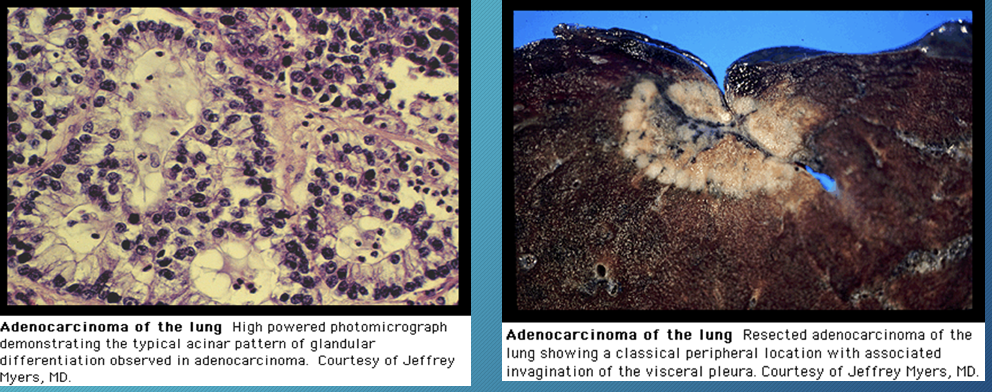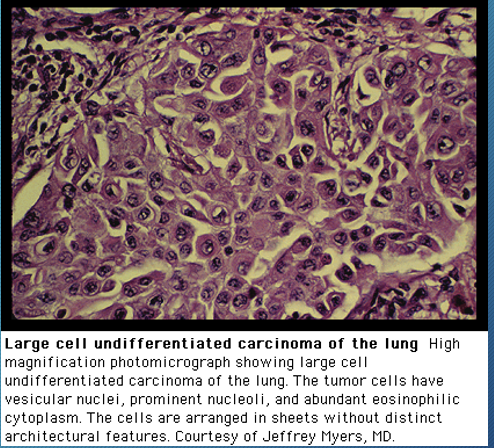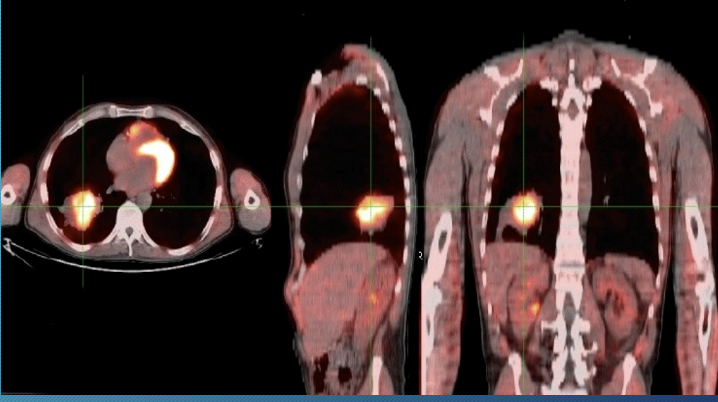lung cancer
1/8
There's no tags or description
Looks like no tags are added yet.
Name | Mastery | Learn | Test | Matching | Spaced |
|---|
No study sessions yet.
9 Terms
symptoms of lung cancer
-most common symptoms: coughing, shortness of breath, chest pain and hemoptysis
-general symptom: fatigue, weight loss and night sweats
paraneoplastic syndrome
-hypertrophic osteoarthropathy (clubbing)
-hypercalcemia
more commonly seen in squamous cell
due to production of PTH-like hormone
-SIADH: most common syndrome in small cell carcinoma
-Cushing syndrome
-Eaton-Lambert syndrome
-does not preclude curative therapy
adenocarcinoma
most common form in nonsmokers
peripheral lesion
-bronchoalveolar cell carcinoma/ adenocarcinoma in situ: subtype of adenocarcinoma
solitary nodule, lobar consolidation or multiple nodules
slow growing with late metastases
lower likelihood of + PET scan

squamous cell carcinoma
2nd most common form of non-small cell carcinoma
found in smokers
associated with hypercalcemia and hypertrophic osteoarthropathy
less likely to metastasize than adenocarcinoma
centrally located and can cavitate

large cell carcinoma
-poorly differentiated non-cell carcinoma that are not classified by light microscopy
-prognosis closely resemble adenocarcinoma
-frequently shows necrosis

small cell carcinoma
10-15% of lung cancers
associated with smokers
central location, metastatic at time of presentation
***If you had to choose a paraneoplastic syndrome related to lung cancer, CHOOSE SMALL CELL (except hypercalcemia)
staging for lung cancer
-non-invasive staging: CT, PET
-invasive staging
non-surgical: EBUS/ bronchoscopy, toracentesi, needle biopsy
surgical: mediastinoscopy, anterior mediastiinotomy (Chamberlain procedure), VATS
Positron emission tomography (PET) scan
marker of active glucose metabolism and will accumulate in metabolically active tumor cells
90% sensitivity, 85% specificity
-false negative: small nodule < 8mm, carcinoid, BAC
-false positive: granulomatous infection/inflammation

video flexible bronchoscopy
excellent to evaluate endobronchial disease
-brushing and bronchial biopsies are high yield for visible lesion
-evaluate of obstruction for stent